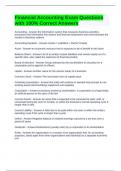Exam (elaborations)
Financial Accounting Exam Questions with 100% Correct Answers
- Course
- Institution
Accounting - Answer-the information system that measures business activities, processes that information into reports and financial statements and communicates the results to decisions makers Accounting Equation - Answer-Assets = Liabilities + Owner's Equity Asset - Answer-an economic resourc...
[Show more]



